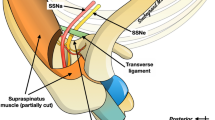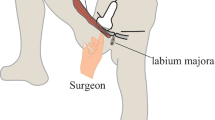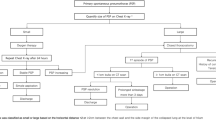Abstract
Purpose
To report the clinical findings of three cases with ultra-late postoperative capsular block syndrome (CBS) by Pentacam Scheimpflug imaging.
Methods
Case series.
Results
Three cases of ultra-late postoperative CBS are presented.
Discussion
This report highlights the importance of conducting Pentacam Scheimpflug imaging in late CBS. Each case either enhanced our understanding or improved our differential diagnosis of late CBS.
Similar content being viewed by others
Introduction
Capsular block syndrome (CBS) is a rare complication of cataract removal.1, 2 It is categorized into three types depending on the time of onset: intraoperative, early postoperative, and late postoperative.3 Late postoperative CBS is typified by the accumulation of a milky-white liquefied substance between the IOL and posterior capsule and capsular bag distention.4, 5 Possible treatments include neodymium:YAG (Nd:YAG) laser capsulotomy6 or surgical lysis of adhesions. Scheimpflug imaging has shown advantages in detecting changes in the anterior segment caused by CBS.7, 8 We present clinical findings in three cases with ultra-late postoperative CBS.
Case reports
Each patient underwent uneventful cataract surgery at our hospital. Anterior segment photography (SL-D7W/DC-3 camera system; Topcon Corporation, Tokyo, Japan) and Pentacam Scheimpflug imaging (Pentacam HR; OCULUS Optikgeräte GmbH, Wetzlar, Germany) were performed before and after Nd:YAG laser posterior capsulotomy. The clinical features of the patients are summarized in Table 1.
Case 1
A 66-year-old man presented with blurry vision in the left eye lasting 5 months. He had undergone phacoemulsification with IOL (Sensar AR40e; Abbott Medical Optics Inc., Santa Ana, CA, USA) implantation in the left eye 12 years earlier. His best-corrected visual acuity during the early postoperative stages was 20/20. At presentation, slit lamp (Figure 1a) and Pentacam (Figure 1b) examinations demonstrated CBS in the left eye. After laser capsulotomy, capsular bag distension was resolved.
Slit lamp and Pentacam Scheimpflug images of ultra-late capsular block syndrome in three cases. Case 1: (a) Slit lamp photograph showing the backward extension of the posterior capsule and the presence of milky-white fluid between the intraocular lens (IOL) and the posterior capsule (white arrow). After maximal dilation, fibrosis of the capsulorhexis opening was visible on the lower nasal side (gray arrow). The IOL was in place. (b) Pentacam Scheimpflug image locates the distended zone before laser treatment. Case 2: (c) Slit lamp photograph showing a curved light band filled with grayish-white opacities (white arrow). However, the IOL was difficult to identify. (d) After maximal dilation, the complete margin of the continuous curvilinear capsulorhexis opening was visible and exhibited significant fibrosis on the temporal side (gray arrow). (e) Pentacam Scheimpflug image showing the contour of the IOL and the underlying milky-white fluid. Case 3: (f) Opacification and fibrosis of the posterior capsule from 7 to 11 O’clock along the temporal side (blue arrow). (g) Boundary of fibrosis and liquefaction. (h) Distention of the capsular bag caused by milky-white liquid on the nasal side (white arrow). Residual cortex was observed inferiorly within the pupillary zone (black arrow). The IOL was in position. (i) Pentacam Scheimpflug image showing the coexistence of residual lens material, liquefied products, and posterior capsular opacification.
Case 2
A 72-year-old woman presented with blurry vision in the right eye lasting 5 years. She had undergone phacoemulsification with IOL (KS-3Ai; STAAR Surgical Co., Monrovia, CA, USA) implantation in the right eye 7 years earlier. Her uncorrected visual acuity gradually decreased from 20/30 to 20/50 after cataract surgery. At presentation, the contour of the IOL in front of the milky-white fluid was better visualized by Pentacam imaging (Figure 1e) than by slit lamp examination (Figures 1c and d). After laser treatment, the patient’s visual acuity significantly improved.
Case 3
A 60-year-old man presented with blurry vision in the right eye lasting 3 months. He had undergone extracapsular cataract extraction with a can-opener-type capsulorhexis and IOL (Akreos Adapt; Bausch+Lomb Inc., Rochester, NY, USA) implantation in the right eye 9 years earlier. Slit lamp examination revealed opacification and fibrosis of the posterior capsule along the temporal side (Figures 1f–h, blue arrow), and distention of the capsular bag and accumulation of milky-white liquid on the nasal side (Figures 1g and h, white arrow). Residual cortex was observed inferiorly within the pupillary zone (Figures 1f–h, black arrow). Slit lamp examination and Pentacam imaging (Figure 1i) demonstrated CBS and posterior capsular opacification (PCO) in the right eye, which were successfully resolved after laser treatment.
Discussion
All cases of ultra-late CBS reported in this case series occurred >7 years after cataract removal by either continuous curvilinear capsulorhexis or can-opener-type capsulorhexis. The longest time from cataract surgery to CBS onset was 12 years (Case 1): this is much longer than the intervals reported in previous case series,9, 10, 11 which ranged from 2 to 92 months. Two cases exhibited high myopia in accordance with Kim and Shin,12 who identified longer axial length as a risk factor for postoperative CBS.
Capsular bag extension and fibrosis of the capsulorhexis margin were evidently observed in our cases. Late postoperative CBS has been described as liquefied after-cataract13 with remarkable posterior capsule distention filled with milky-white, opaque fluids. It contains proteinaceous products of residual lens epithelial cells (LECs),14 producing extracellular matrix and leading to fibrosis. Substances trapped within the capsular bag cause an increase in osmotic pressure and trigger chronic fluid accumulation. The blurring and occlusion of vision caused by opacities and myopia induced by the gradual distension of the capsule finally lower the quality of the visual outcome. With the assistance of Pentacam imaging, Case 3 was presented as a good example of ultra-late CBS, with the coexistence of residual lens material, PCO, and liquefied products (Figure 1i), indicating a possible relationship between the proliferation of LECs, fibrosis, and subsequent liquefaction. Residual LECs of the cortex are not only the reason for PCO but also the source of the milky-white substance,15 and late CBS is most likely a process involving PCO and liquefaction.
In addition to locating and analyzing the distended zone before treatment, Pentacam imaging is also useful in differentiating late CBS from IOL opacification. As shown in Case 2, it is difficult to differentiate IOL opacification from liquid accumulated behind the IOL only by slit lamp examination. Figures 2a and b presents the anterior segment photographs of one of our patients with an opacified IOL, demonstrating its similarity to CBS at first sight. Fortunately, Pentacam imaging facilitates easy identification of where the opacification has occurred (Figures 1e and 2c), thereby assisting doctors in making better clinical and differential diagnoses.
Late postoperative capsular block syndrome and intraocular lens opacification. (a) Anterior segment photos of an opacified intraocular lens case before pupil dilation. (b) Anterior segment photos of an opacified intraocular lens case after pupil dilation. (c) Comparison of late postoperative capsular block syndrome and intraocular lens opacification.
Limited research has been conducted on the changes of ACD in late CBS. Some studies16, 17 found small changes in ACD after laser treatment, as measured by anterior segment OCT. In our three cases, however, an increase in ACD after laser treatment was evident, ranging from 0.20 to 0.45 mm. It is consistent with the case report of Kucukevcilioglu et al.18 We also noted a reduction in myopia after Nd:YAG capsulotomy ranging from −0.75 diopters (D) to −1.00 D (average: −0.83 D). A reduction in myopia after Nd:YAG laser capsulotomy is considered a typical finding in patients with early-onset postoperative CBS,10 while it is not constant in late-onset forms,16, 18 especially in patients with a very delayed onset. Therefore, studies of larger numbers of patients with late CBS are still required.
In conclusion, Pentacam Scheimpflug imaging proved a useful noninvasive technique for diagnosis and follow-up in ultra-late CBS cases.

References
Miyake K, Ota I, Miyake S, Terasaki H . Capsular block syndrome with external blockage of the capsular opening by a ciliary sulcus fixated posterior chamber lens. Am J Ophthalmol 1999; 127 (5): 605–607.
Agrawal S, Agrawal J, Agrawal TP . Complete capsular bag distension syndrome. J Cataract Refract Surg 2000; 26 (9): 1417–1418.
Miyake K, Ota I, Ichihashi S, Miyake S, Tanaka Y, Terasaki H . New classification of capsular block syndrome. J Cataract Refract Surg 1998; 24 (9): 1230–1234.
Morgan-Warren P, Manna A . Late-onset capsular bag distension syndrome following cataract surgery. JRSM Short Rep 2011; 2 (6): 53.
Das K . Delayed capsular bag distension syndrome. Oman J Ophthalmol 2010; 3 (3): 155–156.
Landa G, Hoffman P, Pollack A, Bukelman A, Leiba H, Marcovich A . Outcome of posterior capsulotomy in late capsular block syndrome with posterior capsular opacification. Clin Exp Ophthalmol 2006; 34 (9): 866–869.
Zhu X, Lu Y . Detection and influencing factors of capsular bag distention syndrome after cataract surgery using the Pentacam Scheimpflug system. Am J Ophthalmol 2013; 156 (6): 1134–1140.e4.
Jain R, Grewal D, Gupta R, Grewal SP . Scheimpflug imaging in late capsular bag distention syndrome after phacoemulsification. Am J Ophthalmol 2006; 142 (6): 1083–1085.
Grover DS, Goldberg RA, Ayres B, Fantes F . Treatment of late-onset capsular distension syndrome with a neodymium:YAG laser peripheral iridotomy and anterior capsulotomy. J Cataract Refract Surg 2012; 38 (6): 938–940.
Theng JT, Jap A, Chee SP . Capsular block syndrome: a case series. J Cataract Refract Surg 2000; 26 (3): 462–467.
Starr MB . Capsular bag distention syndrome noted 5 years after intraocular lens implantation. Am J Ophthalmol 1999; 127 (2): 244–245.
Kim HK, Shin JP . Capsular block syndrome after cataract surgery: clinical analysis and classification. J Cataract Refract Surg 2008; 34 (3): 357–363.
Eifrig DE . Capsulorhexis-related lacteocrumenasia. J Cataract Refract Surg 1997; 23 (3): 450–454.
Nishi O, Nishi K, Takahashi E . Capsular bag distention syndrome noted 5 years after intraocular lens implantation. Am J Ophthalmol 1998; 125 (4): 545–547.
Miyake K, Ota I, Miyake S, Horiguchi M . Liquefied aftercataract: a complication of continuous curvilinear capsulorhexis and intraocular lens implantation in the lens capsule. Am J Ophthalmol 1998; 125 (4): 429–435.
Neri A, Pieri M, Olcelli F, Leaci R, Gandolfi SA, Macaluso C . Swept-source anterior segment optical coherence tomography in late-onset capsular block syndrome: high-resolution imaging and morphometric modifications after posterior capsulotomy. J Cataract Refract Surg 2013; 39 (11): 1722–1728.
Tan YL, Mohanram LS, Ti SE, Aung T, Perera S . Imaging late capsular bag distension syndrome: an anterior segment optical coherence tomography study. Clin Ophthalmol 2012; 6: 1455–1458.
Kucukevcilioglu M, Hurmeric V, Erdurman FC, Ceylan OM . Imaging late capsular block syndrome: ultrasound biomicroscopy versus Scheimpflug camera. J Cataract Refract Surg 2011; 37 (11): 2071–2074.
Acknowledgements
This work was supported by the Young Scientists Fund of National Natural Science Foundation of China (Grant No. 81100653) and the New Hundred Talents Program of Shanghai Municipal Health Bureau (Grant No. XBR2011056).
Author information
Authors and Affiliations
Corresponding author
Ethics declarations
Competing interests
The authors declare no conflict of interest.
Rights and permissions
About this article
Cite this article
Zhu, X., Zhang, K., Yang, J. et al. Scheimpflug imaging of ultra-late postoperative capsular block syndrome. Eye 28, 900–904 (2014). https://doi.org/10.1038/eye.2014.107
Received:
Accepted:
Published:
Issue Date:
DOI: https://doi.org/10.1038/eye.2014.107





